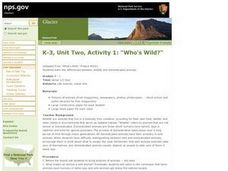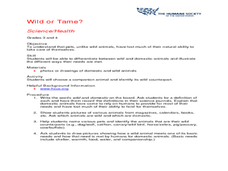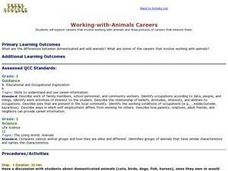Curated OER
Who's Wild?
Students explore the differences between animals of the wild and domesticated animals. In this wild animals instructional activity, students understand that tame animals ancestors were once wild. Students illustrate the differences by...
Curated OER
Artificial Selection
The second lesson in the series begins with a starter activity discussing wild versus domesticated animals. Then, scholars play a card game, with optional variations, to emphasize artificial selection. Next, they attend a field trip to a...
Curated OER
Wild or Tame?
Students explore wild and domestic animals. In this animal lesson, students define wild and domestic. Students are shown pictures of animals and choose if they are wild or domestic. Students name pets and name their wild counterpart....
Curated OER
Wild and Domestic Animals
In this wild and domestic animals learning exercise, learners label animal pictures, watch a video, and complete a word search. Students complete 3 activities.
Curated OER
What's Wild
Third graders discover the differences between wild and domestic animals. In this animal lesson, 3rd graders chart the differences in the animals and look through magazines for pictures of wild and domestic animals to glue to a poster....
Curated OER
Wild or Domestic?
Students identify the differences between wild and domestic animals. In this animal science activity, students list examples of wild and domestic animals and take an online tour of a zoo.
Curated OER
Are you an Animal Sleuth?
Young scholars define and identify both wild and domestic animals as well as mammals and non-mammals. In this animal safety lesson, students distinguish between animals that can carry rabies from those that cannot. Young scholars use...
Curated OER
What's Wild? What's Not?
Students complete activities to differentiate between wild and domestic animals. In this animal types lesson, students bring stuffed animals to class and pictures from magazines or newspaper. Students put their stuffed animals in a box...
Curated OER
Where the Wild Things Shouldn't Be
Students compare and contrast wild and domestic animal needs. For this animal welfare lesson, students read the poem Where the Wild Things Shouldn't Be and create a list of wild and domestic animals. Students create a short play or song...
Curated OER
Wild Or Domestic?
Students discuss differences between wild and domestic animals. They list animals on chart paper, and then cut out pictures from magazines to create large collage showing wild and domestic animals.
Agriculture in the Classroom
A Rafter of Turkeys
How did that turkey get from the early Aztec culture to your table? Learn about the history of wild and domesticated turkeys in North America, as well as their inclusion in Thanksgiving traditions, with a two-part agricultural science...
Curated OER
What's Wild?
Third graders define domesticated animal and wildlife. In this animal lesson, 3rd graders cut pictures out of magazines of both types of animals and make two collages with the pictures.
Curated OER
Elsa the Lioness
Elsa is a lioness who was raised by humans in the 1950's. The Adamsons took her in after George Adamson reluctantly killed her mother. Elsa did return to the wild but maintained a very strong bond with the Adamsons until her death in...
Curated OER
Wildlife Conservation I
Focusing on the wildlife in their area, learners identify endangered and threatened species and what these animals need to survive. While this lesson involves animals in the Long Island area, it could be adapted for use with any area.
Compassion in World Farming Trust
Selective Breeding of Farm Animals
Biology learners read about selective breeding in chickens and how it has produced high-yield meat specimens and rapid egg-layers. The unpleasant effects of artificial selection are explored, as well as options to supporting this...
Curated OER
What's Wild?
Third graders examine pictures of animals before deciding if it is a wild animal or a domesticated animal. They discuss the difference between the two types of animals, where they live, what they eat, and what they need to survive. Using...
Curated OER
Working-with-Animals Careers
First graders list and discuss careers that involve working with animals and draw pictures of careers that interest them. They compare and contrast domestic and wild animals.
Curated OER
Animal Faces-- Full Color Copy
For this art and craft worksheet, learners learn about 12 common wild and domestic animals by cutting out labeled pictures of animal faces. There are no suggestions as to how these could be used.
Curated OER
LIONS and TIGERS and BEARS. . .Oh My! Animals of Connecticut and the World
Students identify and list the different types of pets owned by the children in the class.
They graph the total number of each type of pet owned. They draw or cut-out a picture of an animal. Using the materials listed above, the children...
Curated OER
A Forest Dwellers Quiz
In this forest animals learning exercise, students complete a four question multiple choice on-line interactive quiz. Included are questions about: wild boar, roe deer, red fox and red deer.
Curated OER
Zoo Vet
Students come up with a list of all the animals that might be found in a zoo. They think of all the things that a zoo needs to do and provide for each animal. They discuss what the role of any zoo should be. They design a healthy zoo...
Polar Trec
Calorimetry Lab
Young people between the ages of 11–13 need on average about 2,000 calories per day. Within the lab, groups learn about calorimetry and respiration. They explore how it pertains to humans and animals living the Arctic where cold...
Curated OER
Exploring the Neighborhood -- Literature Jigsaw
Students compare and contrast domesticated animals and wild animals. They identify plants and animals that have adapted to different habitats. They discover it is everyone's responsibility to protect the environment.
Curated OER
All About Ducks for Kids
In this duck facts worksheet, students read series of paragraphs from on online website about ducks. Students may then complete several related duck activities.

























